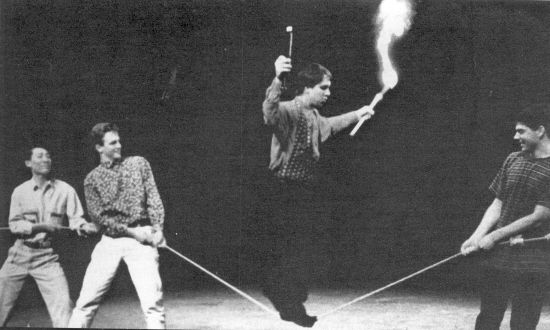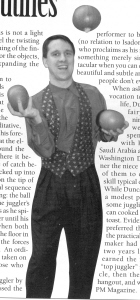
Duncan enlists some audience volunteers for his slackwire routine. |
 |
Page 17 Summer 1993
|
Duncan
Looks Inside His Head For Audience-Pleasing
Routines BY
CINDY MARVELL
The
lights fade out upon an empty stage and the expectant murmur of the audience
dwindles to silence. A mysterious figure can be observed gliding down
the stairs. In the few moments which follow, the spectators are
transported to a place where time and gravity hold no dominion and
effort and skill are masked by the darkness.
Three
luminescent balls take center stage, slowly floating in unpredictable
trajectories and then gradually speeding up until even the jugglers give
up trying to analyze the patterns and resign themselves to the beauty
and mystery of the images.
Soon
the lights come up, and we are back at Mostly Magic, a New York night
club where magicians and their followers commune to witness the
impossible. People are a bit surprised when they behold the creator of
the light show. Somehow, he looks a little younger, or maybe a little
shorter, or maybe just a little more human than what they had imagined.
The
ordinary blends with the mystical as a methodical clicking sound
emanates from five penny-filled tennis balls. They cascade through all
the major patterns - and a few more obscure ones - as if glued to the
air, followed by an exuberant club routine so precise that the front row
gasps as clubs narrowly miss their heads, while the jugglers marvel at
such unusual variations as "reverse
back-crosses." This is not a light and
airy style; one can feel the twisting of the wrists and the reaching of
the fingers as they carve a path for the objects, molding rather than
expanding the space around them.
The
complexities seem to dissolve as the juggler pulls a red stage ball from
his prop bag, explaining that "This represents the essence of my
work." As the music becomes more meditative, the ball rolls up and
down his forearms, changing direction at the elbows, onto the head,
around the face, drops to the feet where it becomes engaged in a game of
catch between them, only to be kicked up into an unbelievable balance on
the tip of the nose. Still it is the final sequence which seems most
beguiling: the ball balances on the back of the juggler's wrist, which
gradually rises as he spirals around
faster and faster until his arm is almost vertical, when both sphere and
juggler sink to the floor in a gesture of obeisance to the forces which
bind them together. An ordinary red ball has suddenly taken on global
dimensions for those who are touched by it.
Those
who can tell a juggler by his claws might have guessed the performer to
be Tony Duncan (no relation to Isadora or the yo-yo), who proclaims as
his motto, "Why do something merely simple and spectacular when you
can do something so beautiful and subtle and complex that people
don't even notice?"
When
asked how such a vocation took hold
of his life, Duncan recalls its fairy-tale
beginnings. Two friends were invited
to spend the evening with
King Faisal of Saudi Arabia and his
niece in Washington DC. After dinner
the niece requested each of them to
demonstrate a skill typical of their
culture.
While Duncan's friend gave a modest presentation of some juggling skills, Duncan cooked his best French toast. Evidently the damsel preferred the pointless to the practical, but our toastmaker had the last laugh two years later when he earned the reputation of "top juggler" in Dupont Circle, then the DC jugglers' hangout, and was featured on PM Magazine. |

Duncan enlists some audience volunteers for his slackwire routine. |
 |